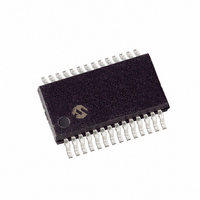PIC18F24J11-I/SS Microchip Technology, PIC18F24J11-I/SS Datasheet - Page 331

PIC18F24J11-I/SS
Manufacturer Part Number
PIC18F24J11-I/SS
Description
IC PIC MCU FLASH 16K 2V 28-SSOP
Manufacturer
Microchip Technology
Series
PIC® XLP™ 18Fr
Datasheets
1.MA180023.pdf
(528 pages)
2.PIC18LF24J10-ISS.pdf
(32 pages)
3.PIC18F24J11-ISS.pdf
(14 pages)
Specifications of PIC18F24J11-I/SS
Core Size
8-Bit
Program Memory Size
16KB (8K x 16)
Core Processor
PIC
Speed
48MHz
Connectivity
I²C, SPI, UART/USART
Peripherals
Brown-out Detect/Reset, POR, PWM, WDT
Number Of I /o
16
Program Memory Type
FLASH
Ram Size
3.8K x 8
Voltage - Supply (vcc/vdd)
2.15 V ~ 3.6 V
Data Converters
A/D 10x10b
Oscillator Type
Internal
Operating Temperature
-40°C ~ 85°C
Package / Case
28-SSOP
Controller Family/series
PIC18
No. Of I/o's
16
Ram Memory Size
3.6875KB
Cpu Speed
48MHz
No. Of Timers
5
Interface
EUSART, I2C, SPI
Processor Series
PIC18F
Core
PIC
Data Bus Width
8 bit
Data Ram Size
3776 B
Interface Type
EUSART, I2C, SPI
Maximum Clock Frequency
48 MHz
Number Of Timers
5
Maximum Operating Temperature
+ 85 C
Mounting Style
SMD/SMT
3rd Party Development Tools
52715-96, 52716-328, 52717-734, 52712-325, EWPIC18
Development Tools By Supplier
PG164130, DV164035, DV244005, DV164005, PG164120, DM183032, DM183022, DM183033, DV164136
Minimum Operating Temperature
- 40 C
On-chip Adc
10 bit, 10 Channel
Lead Free Status / RoHS Status
Lead free / RoHS Compliant
For Use With
AC164331 - MODULE SKT FOR 28SSOP 18F45J10XLT28SS-1 - SOCKET TRANSITION ICE 28SSOP
Eeprom Size
-
Lead Free Status / Rohs Status
Details
- Current page: 331 of 528
- Download datasheet (8Mb)
19.2
The Asynchronous mode of operation is selected by
clearing the SYNC bit (TXSTAx<4>). In this mode, the
EUSART uses standard Non-Return-to-Zero (NRZ)
format (one Start bit, eight or nine data bits and one Stop
bit). The most common data format is 8 bits. An on-chip
dedicated 8-bit/16-bit BRG can be used to derive
standard baud rate frequencies from the oscillator.
The EUSART transmits and receives the LSb first. The
EUSART’s transmitter and receiver are functionally
independent but use the same data format and baud
rate. The BRG produces a clock, either x16 or x64 of the
bit shift rate, depending on the BRGH and BRG16 bits
(TXSTAx<2> and BAUDCONx<3>). Parity is not
supported by the hardware but can be implemented in
software and stored as the ninth data bit.
When operating in Asynchronous mode, the EUSART
module consists of the following important elements:
• Baud Rate Generator
• Sampling Circuit
• Asynchronous Transmitter
• Asynchronous Receiver
• Auto-Wake-up on Sync Break Character
• 12-Bit Break Character Transmit
• Auto-Baud Rate Detection
19.2.1
Figure 19-3 displays the EUSART transmitter block
diagram.
The heart of the transmitter is the Transmit (Serial) Shift
Register (TSR). The Shift register obtains its data from
the Read/Write Transmit Buffer register, TXREGx. The
TXREGx register is loaded with data in software. The
TSR register is not loaded until the Stop bit has been
transmitted from the previous load. As soon as the Stop
bit is transmitted, the TSR is loaded with new data from
the TXREGx register (if available).
FIGURE 19-3:
© 2009 Microchip Technology Inc.
EUSART Asynchronous Mode
EUSART ASYNCHRONOUS
TRANSMITTER
BRG16
TXxIE
Interrupt
EUSART TRANSMIT BLOCK DIAGRAM
SPBRGHx
Baud Rate Generator
TXxIF
TXEN
Baud Rate CLK
SPBRGx
MSb
(8)
TXREGx Register
TSR Register
TX9D
• • •
TX9
8
Data Bus
PIC18F46J11 FAMILY
Once the TXREGx register transfers the data to the TSR
register (occurs in one T
empty and the TXxIF flag bit is set. This interrupt can be
enabled or disabled by setting or clearing the interrupt
enable bit, TXxIE. TXxIF will be set regardless of the
state of TXxIE; it cannot be cleared in software. TXxIF is
also not cleared immediately upon loading TXREGx, but
becomes valid in the second instruction cycle following
the load instruction. Polling TXxIF immediately following
a load of TXREGx will return invalid results.
While TXxIF indicates the status of the TXREGx
register; another bit, TRMT (TXSTAx<1>), shows the
status of the TSR register. TRMT is a read-only bit,
which is set when the TSR register is empty. No inter-
rupt logic is tied to this bit so the user has to poll this bit
in order to determine if the TSR register is empty.
To set up an Asynchronous Transmission:
1.
2.
3.
4.
5.
6.
7.
8.
Note 1: The TSR register is not mapped in data
Initialize the SPBRGHx:SPBRGx registers for
the appropriate baud rate. Set or clear the
BRGH and BRG16 bits, as required, to achieve
the desired baud rate.
Enable the asynchronous serial port by clearing
bit, SYNC, and setting bit, SPEN.
If interrupts are desired, set enable bit, TXxIE.
If 9-bit transmission is desired, set transmit bit,
TX9. Can be used as address/data bit.
Enable the transmission by setting bit, TXEN,
which will also set bit, TXxIF.
If 9-bit transmission is selected, the ninth bit
should be loaded in bit, TX9D.
Load data to the TXREGx register (starts
transmission).
If using interrupts, ensure that the GIE and PEIE
bits in the INTCON register (INTCON<7:6>) are
set.
LSb
0
2: Flag bit, TXxIF, is set when enable bit,
TRMT
memory, so it is not available to the user.
TXEN, is set.
and Control
Pin Buffer
SPEN
CY
), the TXREGx register is
TXx pin
DS39932C-page 331
Related parts for PIC18F24J11-I/SS
Image
Part Number
Description
Manufacturer
Datasheet
Request
R

Part Number:
Description:
Manufacturer:
Microchip Technology Inc.
Datasheet:

Part Number:
Description:
Manufacturer:
Microchip Technology Inc.
Datasheet:

Part Number:
Description:
Manufacturer:
Microchip Technology Inc.
Datasheet:

Part Number:
Description:
Manufacturer:
Microchip Technology Inc.
Datasheet:

Part Number:
Description:
Manufacturer:
Microchip Technology Inc.
Datasheet:

Part Number:
Description:
Manufacturer:
Microchip Technology Inc.
Datasheet:

Part Number:
Description:
Manufacturer:
Microchip Technology Inc.
Datasheet:

Part Number:
Description:
Manufacturer:
Microchip Technology Inc.
Datasheet:










